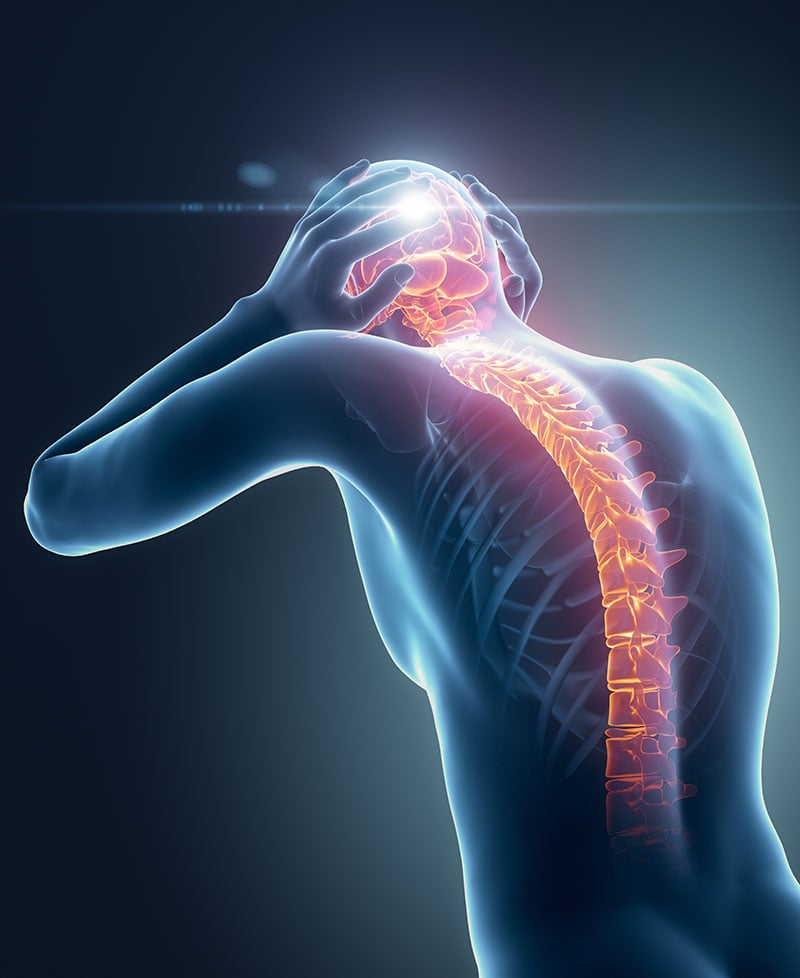Overview
An epidural blood patch injection of a freshly drawn sample of your own blood into the epidural space to “plug the leak” from a spinal headache. There are certain conditions under which patients will have had injections in the spinal column. Examples include an epidural during labor, a diagnostic spinal tap, and a therapeutic spinal injection. A small number of patients will experience a severe headache after the procedure, usually worse with standing and better when lying down. This is due to a persistent leak of spinal fluid into the epidural space. Although the headache itself is harmless, it can be very severe and very debilitating. Your doctor may ask you to come to our clinic for an “epidural blood patch”. This procedure can provide rapid relief.

How is the procedure performed?
Our team will help position you to make sure the procedure can be completed with the least amount of discomfort for you. The skin is cleansed with a sterilizing solution (chlorhexidine) and a sterile drape is placed. A local anesthetic medication typically (Lidocaine) is given to numb the skin. Next, fluoroscopy (x-ray) or ultrasound is used to find the target. At the same time a 10-20cc of blood is typically drawn from a patient's arm. A thin needle is directed to the desired location. The blood is then injected into the epidural space. During the entire procedure you will be constantly monitored by our team. After the injection a small bandage is placed on your skin. You will be given time after the procedure to make sure you feel good and are not having side-effects before leaving the clinic.
What medication is injected?
Typically, only blood is injected. Some studies have shown that saline also works well.
Does the procedure hurt?
The procedure is typically well tolerated. A localized burning sensation from the anesthetic is commonly felt and is usually the most uncomfortable part of the process. During the procedure a pressure sensation is often experienced this typically resolves within a few minutes. Minor soreness for a week after the procedure is normal.
How long does the procedure take?
The procedure typically takes about 15 minutes to perform. Please plan on being at the clinic for about 1 hour to allow for pre and post-procedural safety protocols.
How quickly will I get relief?
The injection typically starts working within minutes. Our team will follow-up with you and determine the need for any future injections.
How long can I expect the relief to last?
The relief should be permanent.
How often can the procedure be repeated?
Depending on results and providers discretion the injections may be repeated.
What are the risks and side effects?
Risks and side effects are minimal and serious complications are rare. We take every precaution to ensure safety. Potential risks may include but are not limited to: vasovagal response (passing out), new or increased pain, infection, bleeding, permanent skin changes, allergic or unexpected drug reaction with minor or major consequences, and unintended nerve injury.
Pre-Procedure Information
Please let us know if you have an active infection, are using antibiotics, or are using blood thinners.
Should I take my normal medications as scheduled?
Yes. Continue taking your prescribed medications prior to procedure.
What if I am on a blood thinner or Aspirin?
Anticoagulation is often stopped for a short period of time prior to injection. Please speak with your primary physician if you take blood thinners to make sure that you can safely stop taking these medications.
Do I need a driver?
Yes. For your safety we require a driver to ensure a safe return home.
Can I eat the day of the procedure?
It depends on the location. We recommend eating a light meal if the injection is done in our clinic. If the procedure is done at the surgery center then you must fast for at least 8 hours prior to the procedure.
Can I get sedation or anesthesia?
Most patients do well without sedation. Light sedation with oral medications is sometimes provided at the provider’s discretion.
What if I am pregnant?
There are serious potential risks to an unborn fetus when exposed to imaging studies, including x-ray and fluoroscopy. If there is any chance you may be pregnant, please postpone this procedure until it can be confirmed that you are not pregnant as it is not safe to do during pregnancy.
What should I wear?
We recommend light loose-fitting clothes. Sometimes we will ask you to change into a gown.
Post-Procedure Information
When can I drive after the procedure?
We recommend resuming driving the next day.
What can I do if I am sore or have pain after the procedure?
Ice packs can be applied to the area for 20 minutes per hour. Over the counter Tylenol and Motrin can be used to aid with any discomfort.
What are my restrictions after the procedure?
Typically, you may resume light activities on the same day following your procedure. Physical therapy can be re-started within 24 hours. We recommend returning to work the day after the procedure.
When can I shower?
Showering the day of the procedure is allowed. For 24 hours you are asked to refrain from submerging or swimming in water. Keep the bandage on for one day.
When do I come back for a follow-up visit?
We follow-up with all of our patients after their procedures. We typically see patients back in 2-4 weeks.
